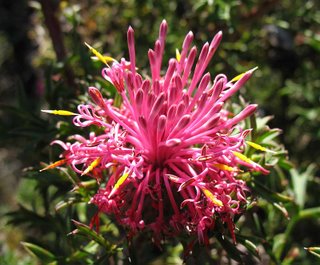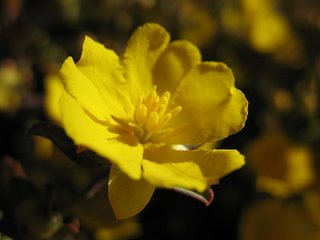
After a very long absence from the fishing scene, yesterday I was back in the game in a major way. My friend Jamie has been hitting up the beaches north of Perth throughout the summer and autumn and now into this very dry beginning of winter and coming back with tales of magnificent catches nearly every time. Along the way he's landed several species of shark including bronze whalers, but also prize fish like pink snappers (off the beach!) and even a schoolie mulloway. Needless to say I've been itching to get out there myself and give it a go and yesterday was the day.
The conditions were nigh on perfect for beach fishing. Clear blue skies, temperatures in the low 20's and a light easterly breeze all day resulting in a glassy calm sea. It really was paradise in the South-West. We arrived about an hour and a half before the high tide (which fell just after midday) and quickly set up our gear. I take my hat off to Jamie for his tackle organisation which was truly first class, a far cry from those rookie beach missions we used to run back in the early days. He had pre-tied all the rigs we needed for the day and neatly quivered them out on a flat piece of styrofoam ready to be tied straight on to the mainline when they needed to be cast into the fray.
And what a fray we stumbled upon. We were fishing a section of beach with a small shallow limestone reef flat right next to shore which guarded a deeper sandy hole immediately further out. Upon arrival, Jamie noticed schools of quite big fish (average 50 cm) banked up under the surface right next to the reef edge. It was an amazing sight, and as it turned out these fish were tailor and there were literally tons of them right there in front of us. We quickly set to work catching sand whiting to be used for fresh bait. The first two casts yielded two perfect little ones which were immediately put on big hooks and cast out into the deep hole. Big hits soon followed on both big rods but nothing was hooked. We wound in to find our little whiting baits chopped neatly in half, a tradmark sign of tailor. Out went another whiting which my wife Lina had caught on the light gear while the blokes manned the big rods, and within a minute Jamie was fighting a good fish (see picture below).

He soon had it in over the reef and landed it amidst the kind of jubilation that invariably accompanies the first decent catch of the day. It was indeed a tailor, just under 50 cm in length which is a good size for the Perth metro area.

In all the excitement of the first catch, I again glimpsed that huge school lurking just at the reef's edge and got the idea to start casting lures into them. I remembered those old fishing articles I'd read years ago about catching tailor with popper lures and thought this would be the perfect opportunity to try out one of my old
Yo-Zuri Hydro Tiger poppers. As soon as I had cast out and started winding in I felt a monstrous hit and saw a big flash of silver at the surface. All of a sudden there was a fierce pull on the line and I knew I was on! What an adrenaline rush! I pulled back on the rod and tried winding in but the fish wasn't coming and was severely testing out my light gear. Still, the 5kg mono line should have been adequate to land this fish, as long as it didn't run me under the reef (a very probable scenario). After the initial tug-o-war between myself and the tailor, I muscled it in a bit closer to the reef edge and luckily a wave surged over with perfect timing, washing it right up close to my feet. There it was: my first ever tailor on a popper, what a rush!!!


What followed next was breathtaking. As soon as the formalities of photographing and bleeding the catch were over I was straight back down to the water casting the popper. And again I had an almost instant strike only this time the fish was bigger and fought much harder! I couldn't even budge it to begin and was really concerned that I was going to get busted off at any second. Thankfully the waves came to my rescue again and as one surged up behind the fish it turned shoreward allowing me to retrieve about five metres of line which put it right next to the edge of the reef. Now came the moment of truth. I had my first good look at it and confirmed that it was substantially bigger than the first one. It broadsided me, hanging there like a spinniker in the breeze poised to either come in on the next wave or bust me off. Obligingly it came in on top of the reef on the next wave by which time Jamie was knee-deep in the water ready to pounce with the gaff. My pulse was racing as I saw it close-up for the first time but just as Jamie was shaping to gaff it, the big tailor managed one final burst of energy and busted the line clean away and it was gone. These are the kinds of fishing moments that almost require counselling sessions afterwards. I was very disappointed on two counts, I'd lost the fish of the day and also the gun popper.

Luckily I had another popper in my bag (next size up but the same Yo-Zuri tiger pattern) and not wanting to waste a second while the tailor were in this kind of form, tied it onto the big rod with heavier line. I didn't want to lose another lure or another fish. No sooner had I cast out again when I got another monstrous hit on the popper but no hook-up. Outrageous action! I frantically wound in to cast again but as the popper approached the reef-edge another lurking tailor engulfed it and got hooked up big time. Once again I found myself in a no-holds-barred pulling match with a tough WA tailor. This was another big one too, not quite as big as the one that got away but almost. It was certainly advantage me having the bigger rod and the heavier line and after a brief but strong tussle I had my second tailor in over the reef top and onto the beach. Top stuff. This fish went so hard at the popper that it hooked up not only in the scissors of the jaw, but also foul hooked itself in the breast just above the pelvic fins (see photo below).

After this one was caught, the action really died down. I tried repeatedly for another one on poppers but they weren't obliging me at all. It seemed that the rest of the school had wised up and moved on after three of their biggest cohorts had tangled with my poppers. With high tide past we settled back into our chairs and played the waiting game. Jamie ended up catching two more tailor around the 50 cm mark on his breakaway rig and Lina even got in the game with her first ever tailor on the same rig using a fresh strip of tailor for bait. We spent the rest of the arvo waiting for something special which never came but we sure took a lot of heart from our earlier tailor exploits and the beautiful sunset over the calm Indian Ocean just before we packed up and headed back to Jamie's for a char of fresh tailor fillets.

All in all it was a top day in the South-West.

























